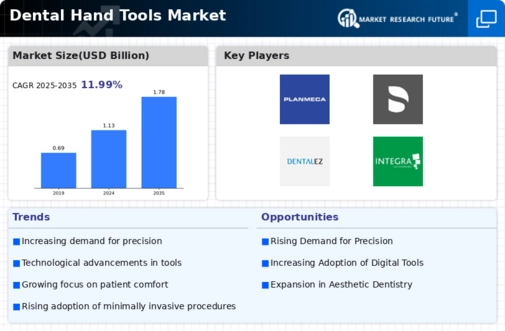Market Share
Dental Hand Tools Market Share Analysis
In the dynamic landscape of the Dental Hand Tools Market, companies employ a range of strategies to secure and enhance their market share. Differentiation is becoming increasingly popular with corporations specializing in superior Dental Hand Tools. This includes those used for precision in conducting procedures like scaling, root canal treatment, or even extractions designed to offer improved precision as well as last longer. The Dental Hand Tools Market operates through a cost leadership strategy. Practices have been focused on reducing production costs at all levels and hence offering less expensive medical devices. Still, keeping equipment costs reasonable and attracting some dental providers or practices looking for high-quality tools that add value to dental operations without majorly increasing these expenses would make an attractive business model. The Dental Hand Tools Market has companies that are positioning themselves for specific niche markets. Customizing tools for various dentistry specialties such as endodontics, periodontics, or oral surgery is very important. Geographical placement is a business move whereby manufacturers of Dental Hand Tools adapt their products to meet the needs of regional regulatory standards and dental preferences. Understanding local dental practices and modifying products in line with location guidelines thus enables a company to penetrate diverse markets effectively. Some of these firms can concentrate on areas with a higher rate of distinct dental procedures. In contrast, others take advantage of locations where there is a growing demand for sophisticated Dental Hand Tools. The Dental Hand Tools Market relies heavily on collaboration, which shapes partnerships between companies in order to improve their capabilities and market reach. These collaborations may be through partnering with dental schools, research institutions, or other manufacturers of dental equipment to co-develop and verify Dental Hand Tools. Mergers and acquisitions are strategic moves that shape the competitive landscape of the Dental Hand Tools Market. For instance, by acquiring other companies, firms can complement their technologies, broaden their portfolios in terms of intellectual property rights, or consolidate positions as leaders in the field of Dental Hand Tools production. Introducing new tools into the market, making them comfortable during use, and increasing performance in any dentistry process is majorly why businesses invest in research & development, hence contributing towards continuous improvement within this industry sector. This way, they can keep pace with changing demands from dentists, evolving regulations governing clinical practice, and shifting market trends. Innovation does not only address the needs of practitioners but also makes firms become significant contributors toward advancing technology in dental instruments.







Leave a Comment